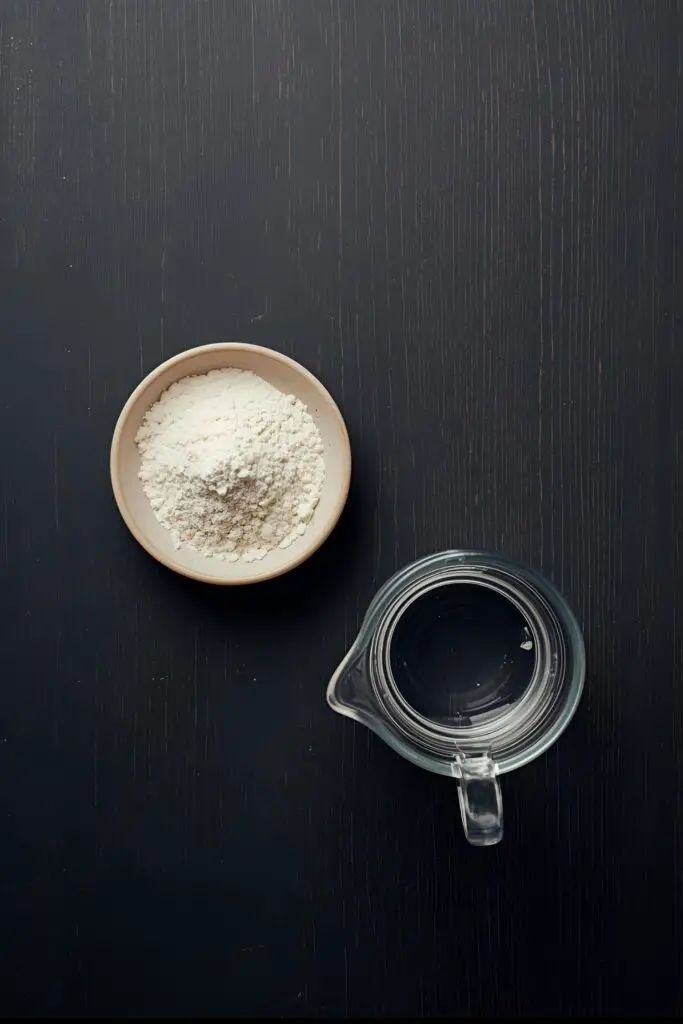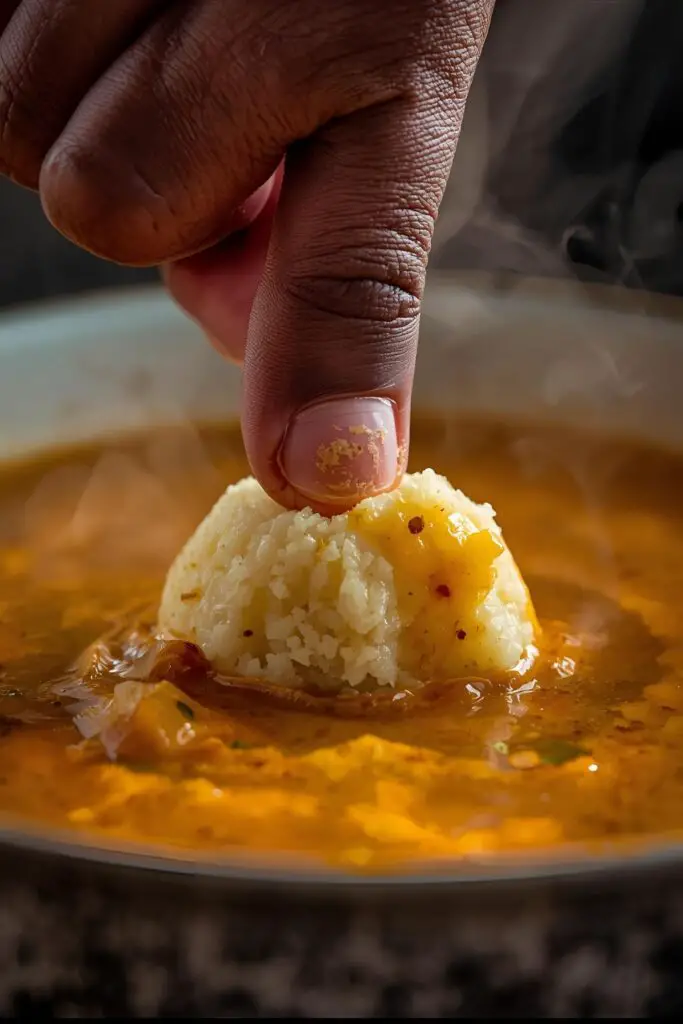How to Make Fufu: The Easy Guide to Africa’s Favorite Comfort Food
You’ve seen it on TikTok, right? That soft, pillowy, magical ball of white dough being expertly dipped into a gloriously vibrant soup. You’re mesmerized, you’re intrigued, and you’re probably thinking, “What is that and how can I get it in my belly immediately?” My friend, you’ve stumbled upon the wonder of fufu. And before you assume it’s some complicated culinary feat, I’m here to show you how to make fufu using a modern, super-easy method that will have you dipping in no time. No giant wooden pestle required (unless you want to skip arm day at the gym).
Why This Fufu Recipe Is Your New Best Friend
So, why are we dedicating a whole post to what is essentially a two-ingredient recipe? Because fufu is more than just food; it’s an experience. This recipe is awesome because it’s the ultimate blank canvas, a perfect, neutral-tasting swallow designed to be the perfect vehicle for intensely flavorful soups and stews. It’s the culinary equivalent of a cozy blanket on a rainy day. Plus, it’s ridiculously easy and cheap to make at home. Imagine serving up a beautiful, authentic African meal and casually mentioning, “Oh yeah, I made the fufu from scratch.” You’ll look like a worldly culinary genius. TBH, it’s one of the easiest things you’ll ever make.
The (Almost Comically Short) Ingredient List
Prepare yourself for the simplest ingredient list you’ve ever seen for something so iconic.
- Fufu Powder: 1 cup. This is the key. You can find it at any African, Caribbean, or international grocery store, and increasingly online. It’s typically made from dried and pounded cassava, plantain, or cocoyam.
- Water: 2 cups, divided. Yep, that’s it. One part powder, two parts water is a great starting ratio.
Your Fufu-Making Arsenal
You don’t need much, but what you do need is mighty.
- A Medium-Sized Pot: A non-stick pot will make your life significantly easier when it comes to cleanup.
- A Very Sturdy Wooden Spoon or Spatula: I cannot stress sturdy enough. You’re about to engage in some vigorous stirring, and a flimsy spoon will not survive the battle. This is its moment to shine.
- Measuring Cups: To get your ratios right.
- A Small Bowl of Water: For shaping the fufu at the end.
Let’s Get Ready to Tumble: Step-by-Step Instructions
Alright, let’s turn that powder into pillowy perfection. It’s all about the technique.
H3: Step 1: Make the Slurry (The Secret to No Lumps)
In your pot off the heat, combine the 1 cup of fufu powder with 1 cup of cold or room temperature water. Do not use hot water! Using hot water is a one-way ticket to Lump City, and it’s a sad place to be. Stir vigorously with your wooden spoon until you have a smooth, lump-free paste that looks a bit like Elmer’s glue.
H3: Step 2: Bring the Heat and Begin the Stir
Once you have a smooth slurry, place the pot on your stovetop over medium heat. Now, the workout begins. Start stirring. And I mean, start stirring and do not stop. For the first couple of minutes, it will be a liquid, and you’ll think, “This is easy, what was all the fuss about?” Oh, you sweet summer child. Just wait.
H3: Step 3: The Transformation (It’s Science!)
After a few minutes of constant stirring, you’ll feel it start to thicken. The mixture will begin to pull away from the sides of the pot and form a cohesive ball of dough. Keep stirring and folding it over on itself. You’re essentially cooking the starch and developing the classic stretchy texture. This part should take about 5-7 minutes. Your arm might start to complain. Tell it to be quiet; deliciousness is at stake.
H4: Step 4: The Final Stretch
Once you have a thick, solid mass, add about ½ cup of the remaining water. It will look weird and separated at first, but keep stirring and folding with your spoon, pressing down to incorporate the water. The dough will become softer and stretchier. You can add the last ½ cup of water if you prefer an even softer consistency. Keep cooking and stirring for another 3-5 minutes to ensure the raw flour taste is completely gone.
H5: Step 5: Shape and Serve
Turn off the heat. To shape the fufu, dip a small bowl in water to wet it. Scoop the hot fufu into the wet bowl. Gently shake and swirl the bowl until the fufu forms a smooth, round ball. Carefully turn it out onto a plate. You can also shape it by hand, but be sure to wet your hands first as the dough is hot and sticky. Serve it immediately with your favorite soup.
Calories & Nutritional Info: The Nitty-Gritty
Fufu is a staple food, meaning it’s a primary source of energy. It’s a carb-lover’s dream. Here’s a rough idea for a single serving (about half the recipe):
- Calories: Approximately 250-300 kcal
- Carbohydrates: Around 60-70g
- Fat: Less than 1g
- Protein: About 1-2g
- Fiber: A decent source, depending on the flour base.
It’s a wholesome, filling, and gluten-free source of energy that will keep you full for hours.
Common Mistakes to Avoid: Your Fufu Foul-Up Prevention Guide
It’s a simple process, but there are a few places you can go astray. Let’s avoid that.
- Starting with Hot Water: I’ve said it before, but it bears repeating. Starting your slurry with hot water will cook the starch instantly, creating a lumpy mess that you can never stir out. Always start with cold water.
- Not Stirring Constantly: If you walk away from the pot, the bottom will burn and you’ll get lumps. This recipe requires your undivided attention and your arm strength. Embrace the stir.
- Giving Up Too Soon: You have to cook the fufu until the raw, floury taste is gone and the texture is right. If you stop stirring when it just forms a ball, it will be undercooked. Go the distance.
- Using a Flimsy Spoon: You will break your spoon. You will be sad. You will have a piece of plastic in your fufu. Use a strong wooden spoon.
Variations & Customizations: Exploring the World of Swallows
While fufu from powder is fantastic, it’s just one type of “swallow” food.
- Traditional Pounded Fufu/Yam: For the ambitious! This is the OG method. It involves boiling starchy tubers like yams, cassava, or plantains until tender, then pounding them in a large mortar and pestle until a smooth, elastic dough is formed. It’s a serious workout and a two-person job, but the texture is unparalleled.
- Oat or Semolina Fufu: A modern, non-traditional take. You can make a similar swallow food using oat flour or semolina flour and water, cooked in the same way. These have a different flavor and texture but are great high-fiber alternatives.
- What to Serve with Fufu: This is the best part! Fufu is a team player. Pair it with classic West African soups like Egusi Soup (made with ground melon seeds), Okra Soup, Light Soup (a thin, tomato-based broth), or Groundnut (Peanut) Soup.
FAQ Section: All Your Fufu Questions, Answered
Let’s tackle some of the most common questions about this delicious dish.
Q1: What does fufu taste like on its own?
A: Fufu has a very mild, neutral taste. Depending on the flour, it can be slightly earthy (cassava) or subtly sweet (plantain). Its main purpose is to be a bland, starchy vehicle for flavorful soups, so it doesn’t have a strong taste itself.
Q2: How are you supposed to eat fufu? Do you chew it?
A: You eat fufu with your right hand (in many cultures, the left hand is considered unclean). Pinch off a small piece, roll it into a ball, make an indentation with your thumb, and use it to scoop up your soup. And here’s the kicker: you generally swallow it without chewing. The fufu acts as a vessel, carrying the richly flavored soup directly to your palate.
Q3: What is fufu flour actually made of?
A: It depends on the brand and region. The most common types are made from fermented and dried cassava, unripe plantains, or cocoyam (a root vegetable similar to taro).
Q4: Is fufu healthy?
A: It’s a healthy source of complex carbohydrates, which provide sustained energy. It’s low in fat and cholesterol. Like any starchy food, it’s best enjoyed in moderation as part of a balanced meal (i.e., with a nutrient-rich soup).
Q5: Help! My fufu is lumpy. What did I do wrong?
A: You most likely started with water that was too warm, or you didn’t stir vigorously enough at the beginning to create a smooth slurry before the heat started to cook it.
Q6: Can I make fufu in the microwave?
A: Yes, this is a popular modern hack! Mix the powder and water in a large, microwave-safe bowl. Microwave on high for 2-minute intervals, stirring very well in between each interval, until it’s cooked through (usually about 6-8 minutes total).
Q7: How do I store and reheat leftover fufu?
A: Wrap leftover fufu tightly in plastic wrap and store it in the fridge for up to 2 days. To reheat, you can either microwave it (sprinkle with a little water first) or wrap it in foil and steam it for a few minutes.
Final Thoughts: You Are Now a Fufu Master!
Look at you! You’ve successfully transformed a humble powder into a staple food enjoyed by millions. You’ve had an arm workout and a culinary lesson all in one. Now comes the best part: sitting down with a big bowl of savory soup and enjoying the fruits (or rather, tubers) of your labor. Go forth, dip, and swallow. You’ve earned it.




